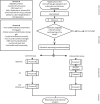Effect of an educational booklet for prevention and treatment of foot musculoskeletal dysfunctions in people with diabetic neuropathy: the FOotCAre (FOCA) trial II, a study protocol of a randomized controlled trial
- PMID: 32054510
- PMCID: PMC7020575
- DOI: 10.1186/s13063-020-4115-8
Effect of an educational booklet for prevention and treatment of foot musculoskeletal dysfunctions in people with diabetic neuropathy: the FOotCAre (FOCA) trial II, a study protocol of a randomized controlled trial
Abstract
Background: This study is a part of a series of two clinical trials. We consider diabetic polyneuropathy (DPN), a common chronic and progressive complication of diabetes mellitus that has several impacts on individuals' foot health and quality of life. Based on the current trends of self-monitoring and self-care, providing a tool with foot-related exercises and educational care may help patients to avoid or reduce the musculoskeletal complications resulting from DPN, improving autonomous performance in daily living tasks. The aim of this trial is to evaluate the effects of an educational booklet for foot care and foot muscle strengthening on DPN symptoms and severity, clinical outcomes, and gait biomechanics in patients with DPN.
Methods/design: The FOotCAre (FOCA) trial II study has been designed as a single-blind, two-parallel-arm randomized controlled trial. It will include 48 patients with DPN who will be randomly allocated to a control (recommended foot care by international consensus with no foot exercises) group or an intervention (foot-related exercises using an educational booklet three times/week at home for 8 weeks) group. Participants from both groups will be assessed at baseline, after 8 weeks, and at 16 weeks for follow-up. The primary outcomes are the DPN symptoms and severity, and the secondary outcomes are foot-ankle kinematics, gait kinetics, plantar pressure distribution during gait, tactile and vibratory sensitivities, foot strength, functional balance, and foot health and functionality.
Discussion: The booklet is a management tool that allows users to be autonomous in their treatment by choosing how and where to perform the exercises. This allows the patients to perform the exercises regularly as a continuous habit for foot care and health, which is an important element in the management of the diabetic foot. As the booklet focuses on specific foot-ankle exercises, we expect that it will improve the clinical aspects of DPN and produce beneficial biomechanical changes during gait, becoming a powerful self-management tool that can be easily implemented to improve the performance of daily living tasks.
Trial registration: ClinicalTrials.gov, NCT04008745. Registered on 2 July 2019.
Keywords: Clinical trial; Diabetic foot; Diabetic neuropathies; Exercise; Foot ulcer; Physical therapy; Preventive care.
Conflict of interest statement
The authors declare that they have no competing interests.
Figures
References
-
- International Diabetes Federation. IDF Diabetes Atlas. 8th ed. Brussels: International Diabetes Federation; 2017.
Publication types
MeSH terms
Associated data
Grants and funding
- 407252/2018-5/Conselho Nacional de Desenvolvimento Científico e Tecnológico
- 304124/2018-4/Conselho Nacional de Desenvolvimento Científico e Tecnológico
- Financial Code 001/Coordenação de Aperfeiçoamento de Pessoal de Nível Superior
- Financial Code 001/Coordenação de Aperfeiçoamento de Pessoal de Nível Superior
- 2017/15449-4/Fundação de Amparo à Pesquisa do Estado de São Paulo
LinkOut - more resources
Full Text Sources
Medical
Research Materials


